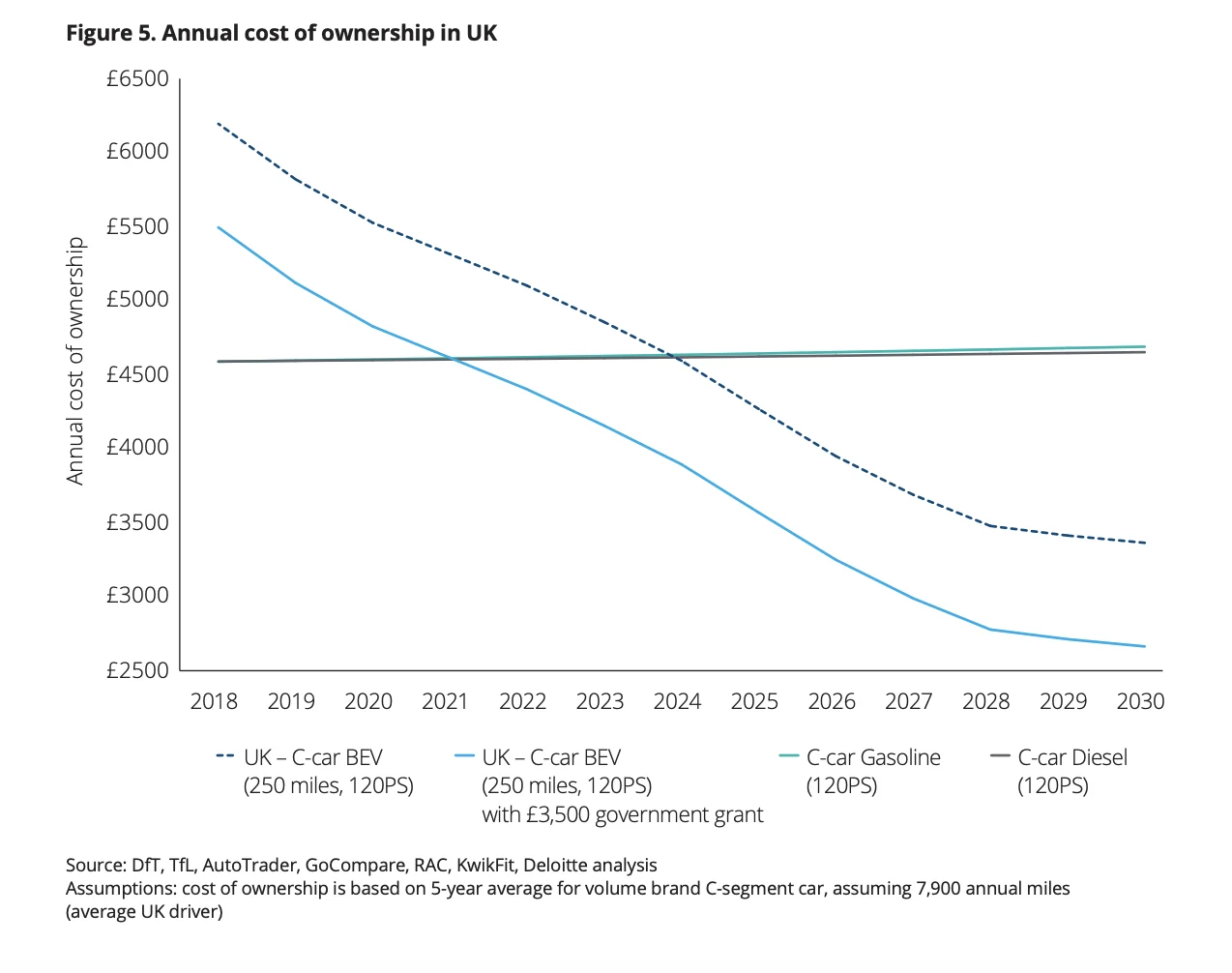New Features, Sustainability
Everything You Need to Know About Electric Vehicles for Your Fleet
February 7, 2020

Get the latest from Samsara
Subscribe nowIf you’re a business owner, CEO or fleet manager, you may have already heard of corporate social responsibility (CSR)—a set of business practices that aims to help organizations practice social, economic, and environmental sustainability. While CSR and sustainability efforts can have a positive impact on larger societal efforts, they can also help you increase your bottom line.
In recent years, more organizations are beginning to focus on environmental sustainability, particularly through the adoption of electric vehicles (EVs). Companies like DHL and UPS are leading the way towards electrifying their fleets and local governments are also getting in on the act.
How does this help the bottom line? According to a report by Deloitte, globally the cost of ownership between EVs and traditional gas-powered vehicles will be the same by around 2024. Further, as illustrated by the chart below, the report predicts that owning an EV in the UK—and other similar markets—will be significantly cheaper than owning a gasoline or diesel vehicle by 2030, saving you upwards of £1000 or $1,300.

As the move to zero-emissions gains traction and advances in technology help lower the overall cost of EVs, electric fleets are increasingly becoming a reality. Read on to learn more about EVs and the benefits they could offer your fleet.
Why now?
According to the Center for Climate and Energy Solutions, seven countries are responsible for nearly two-thirds of all greenhouse gas emissions worldwide. The United States and the European Union (EU) together emitted nearly a quarter of global greenhouse gas emissions in 2017, along with other top emitters such as China, Russia, India, Japan, and Brazil.
In the EU, fuel combustion for transport is the second-highest source of emissions, contributing to 25% of its total greenhouse gas emissions in 2017. In 2016, the transportation sector became the primary source of greenhouse gas emissions in the United States, with almost a quarter of transportation-related emissions coming from trucks used for freight transportation.
EVs, which are now available for commercial applications, can help reduce emissions. Electrification—the process of incorporating EVs into your fleet—can help fleets achieve sustainability goals and lower their total cost of ownership.
There are also a number of financial incentives offered by various governments for implementing the technology. For instance, the United Kingdom will offer to cover up to 35% of the purchase price of an EV, or up to a maximum of £4,500, while a number of U.S. states are also offering incentives for those turning to alternative fuels.
Additionally, EV adoption is gaining popularity as cities across the globe begin to outlaw internal combustion engines (ICE) within their borders. Central London, for instance, launched an ultra-low emission zone in 2019, whereby vehicles that don’t meet the newer, more stringent emissions requirements must pay a fee to operate in that area. Many other countries, like France and Germany, have also announced that they will phase out the sale of conventional cars by 2040 and automakers like Daimler and Kenworth are rolling out plans to electrify their vehicle offerings.
Benefits of EVs for your fleet
As the upfront cost of EVs falls, you might be considering adding electric vehicles to your fleet. Read on to learn more about the benefits of EVs for your fleet.
1. Lower your total cost of ownership (TCO)
Some of the advantages that EVs have when compared to traditional gas-powered vehicles are related to fuel and maintenance costs.
According to the Department of Energy, it costs less than half to travel the same distance in an EV as it does in a conventional vehicle. Not only is electricity generally cheaper than fuel EVs are also more efficient than their gasoline-powered counterparts. Based on findings by the U.S. Department of Energy, an electric motor only incurs 15% to 20% energy loss compared to 64% to 75% for a gasoline engine. So even though your electricity costs could increase if you have EVs, your overall TCO would decrease. You can see exactly how much an EV could save you in fuel costs by using the Department of Energy’s calculator here.
Additionally, EVs don't require the regularly scheduled maintenance or state emission checks that ICE vehicles often do in order to run reliably. Fewer scheduled maintenance stops and less upkeep can help reduce the TCO of each vehicle, and will also mean less downtime for drivers.
2. Win government incentives
As the urgency around reducing the global carbon footprint increases, governments around the world are using financial incentives to attract new EV customers.
Like the United Kingdom, the United States federal government is also offering tax credits for lowering the upfront costs of plug-in electric vehicles. Tax credits range from $2,500 to $7,500 per new electric vehicle purchased for use in the U.S. with the tax credit depending on the size of the vehicle and its battery capacity.
3. Improve fleet efficiency and driver quality of life
While trucks only account for about 7% of American urban traffic, they are responsible for a disproportionate 17% of total congestion costs—that’s about $28 million in wasted hours and fuel costs.
While many cities prohibit nighttime and early morning deliveries so as not to disturb residents’ sleep, electric delivery vehicles don’t have that problem. Incorporating electric trucks and service vehicles with quiet and emission-free engines can enable a shift in driving hours. Driving at times when there’s less traffic, such as at night or early in the morning, can help avoid delays and increase efficiency across your fleet. Further, as cities increasingly create zero-emissions zones, fleets with electric trucks would have the added advantage of being able to make deliveries in those areas.
Quieter vehicles can also help to improve driver quality of life, reducing the amount of noise pollution drivers are subjected to while working long shifts.
Potential EV Fleet Challenges
While electric vehicles can offer a number of benefits to your fleet, and your bottom line, they are not without their limitations. Range anxiety—anxiety about the distance an EV can travel on a single charge—for instance, is still a challenge for some vehicles. Read on to learn more about some factors to consider if you’re thinking about adding EVs to your fleet, and ensure that your telematics and vehicle tracking systems are built to support your electrification efforts.
1. Charge anxiety
Charge anxiety—the fear of not having sufficient battery life to complete a round-trip and not being able to find a charging station in time—is arguably one of the biggest challenges that may be associated with having an electric fleet. Historically, the average EV hasn't been able to travel as far as the average gas-powered vehicle and may run out of charge before getting to a charging station. Though many EVs have been released today that can travel distances of up to 200 or 300 miles, drivers who are not accustomed to driving EVs may still worry that they may not be able to make it to their destination without needing to stop to charge.
Additionally, EVs take longer to “refuel” than gas-powered vehicles. While fast charging stations can recharge the battery in about 30 minutes, many EVs can take more than eight hours to fully recharge—a lot longer than the few minutes it takes to fill up a gas tank. While this limited range may be sufficient for short trips, fleets that need to reliably travel longer distances will need to prioritize route planning in order to avoid lower vehicle utilization.
Because of these constraints, organizations using EV fleets need to plan their routes and schedules more carefully and incorporate time for recharging.
2. Cold weather
Batteries on electric vehicles are much like human beings—they prefer a limited temperature range of 60 to 80 degrees Fahrenheit for optimal performance.
EVs typically run on lithium-ion batteries. When the temperature falls below approximately 40 degrees, the electrolyte fluid inside the battery cells thickens and slows down. Gas-powered cars generate their own heat, which helps keep the engine warm even when the temperature drops. But EVs lack an internal combustion engine and quickly lose energy when running in cold weather. Additionally, drivers will turn up the heat when it’s cold, which will further drain the vehicle’s battery.
Preparing for cold weather can be particularly challenging for fleets that need to operate year-round and travel long distances.
3. Battery health
Another oft-cited concern relates to the overall performance of EV batteries. Advances in technology mean that EVs can increasingly travel longer distances and can be charged faster. However, according to research from Deloitte, continued fast charging can reduce the total capacity of an EV battery, which might affect the overall range of the vehicle over time.
With EVs and ICE vehicles alike, the way you drive your vehicle will have an impact on vehicle performance and battery health. Battery degradation in EVs can be caused by multiple factors, including overcharging (regularly charging your battery up to 100%), deep discharging (running your EV battery down to 0% charge), and operating and storing your EV in high temperatures.
You can ensure the optimal performance of your electric vehicle by:
Avoid charging extremes: EV batteries operate best when they are maintained between 80% to 20% charge. Additionally, frequent fast charging can lead to your battery temperature increasing which can lead to further battery degradation.
Avoid temperature extremes: EV batteries work best when maintained at a constant temperature of between 60-80°F/15-25°C.
Use safe driving practices: Safe driving behaviors such as avoiding harsh acceleration and harsh braking can help preserve EV battery life by not putting as much strain on the battery. When applied to ICE vehicles, these practices are sometimes referred to as ‘eco-driving’. A number of European countries have integrated these principles into their driver training programs in an attempt to reduce carbon emissions, preserve their vehicles, and consume less fuel.
How telematics can help
While EV adoption can present some challenges, the good news is that a telematics system built to support electric vehicles can help alleviate these challenges, so that you can reap the full benefits of an electric fleet, improving total cost of ownership and performance for your fleet as well as reducing your overall carbon footprint. While you will want traditional fleet management features, such as vehicle utilization and GPS tracking, there are a handful of new metrics you will need to consider with an electric fleet. These include state-of-charge (how much charge an electric battery currently has relative to its capacity, also called SoC) and charging session details.
For instance, charging EVs can take significantly longer than filling up a gas-powered vehicle. The right telematics system can provide you with the visibility you need to plan routes with the most optimal charging times and locations when you're planning your deliveries and help you avoid unnecessary charging stops. For example, you might prefer fewer stops for longer times instead of stopping your drivers more frequently—a fleet management system for EVs can help you optimize your routes to maximize vehicle range between charging stations. Telematics systems for EVs can also help you compare and analyze fuel and energy consumption across the various vehicles in your fleet. This allows you to see which of your vehicles are the most efficient as well as see the carbon impact of your fleet over time.
Ultimately, there’s lots of opportunity in terms of both cost savings and environmental impact when using an electric vehicle fleet. But before adopting EVs or expanding your EV fleet, ensure that you have a comprehensive fleet management solution in place that allows you to effectively manage the challenges that EVs might present.
Samsara’s technology has helped customers improve energy efficiency and reduce fuel use across their fleets, saving over 24 million gallons of gasoline—or $80 million in cost savings—each year. Going forward, we’re excited to continue our tradition of sustainable innovation by continuing to invest in new products for our customers who might be considering adopting EVs for their fleets. To learn more about how we’re achieving these goals and what plans we have for the future, check out our commitment to sustainability.
Get the latest from Samsara
Subscribe now
















